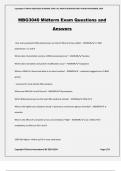Copyright © KAYLIN 2024/2025 ACADEMIC YEAR. ALL RIGHTS RESERVED FIRST PUBLISH NOVEMBER, 2024
MBG3040 Midterm Exam Questions and
Answers
How many eukaryotic RNA polymerases are there? What are they called? - ANSWER✔✔-3- RNA
polymerase I, II, and III
Where does transcription and pre-mRNA processing occur? - ANSWER✔✔-Nucleus
Where does translation and protein modification occur? - ANSWER✔✔-Cytoplasm
Where is RNA Pol I found and what is its main function? - ANSWER✔✔-- nucleolus (suggests txn of rRNA
genes)
- accounts for most cellular RNA synthesis
Where are RNA Pol II and III found? - ANSWER✔✔-Nucleoplasm
Which RNA polymerase has the least RNA synthesis activity? - ANSWER✔✔-RNA Pol II
What is the highly toxic substance found in poisonous mushrooms (genus Amanita)? - ANSWER✔✔-α-
amanitin
What is the effect of α-amanitin at low concentrations? High? - ANSWER✔✔-Low: inhibits Pol II
completely, no effect on Pol I and III
1000-fold higher: inhibits pol III in most eukaryotes
Copyright ©Stuvia International BV 2010-2024 Page 1/53
,Copyright © KAYLIN 2024/2025 ACADEMIC YEAR. ALL RIGHTS RESERVED FIRST PUBLISH NOVEMBER, 2024
What does RNA Pol I make the precursors to? - ANSWER✔✔-28S, 18S and 5.8S rRNAs
What does RNA Pol II make the precursors to? - ANSWER✔✔-mRNAs, snRNAs, miRNAs
What does RNA Pol III make the precursors to? - ANSWER✔✔-tRNAs, 5S rRNA, other small RNAs
What is the significance of 7SL RNA? - ANSWER✔✔-Component of the signal recognition particle (SRP)
universally required for co-translational protein targeting
What is the significance of 7SK RNA? - ANSWER✔✔-Plays role in regulating transcription by controlling
the positive transcription elongation factor P-TEFb
What does P-TEFb stand for and what does it do? - ANSWER✔✔-- positive transcription elongation factor
- multiprotein complex that plays essential role in regulation of txn by RNA Pol II in eukaryotes
What is hnRNA and what polymerase produces it? - ANSWER✔✔-- ill-defined class of RNA produced by
RNA Pol II
- most hnRNAs are precursors of mRNA (pre-mRNA)
What do small nuclear RNAs do? - ANSWER✔✔-snRNAs participate in the maturation of hnRNAs to
mRNAs
What do microRNAs do? - ANSWER✔✔-miRNAs control expression of many genes by causing
degradation of, or limiting the translation of their mRNAs
How many subunits do the three RNA Pol have? What are the common ones? - ANSWER✔✔-- ~12
subunits each
- 5 common subunits: RPB5, 6, 8, 10, and 12
Copyright ©Stuvia International BV 2010-2024 Page 2/53
,Copyright © KAYLIN 2024/2025 ACADEMIC YEAR. ALL RIGHTS RESERVED FIRST PUBLISH NOVEMBER, 2024
What are the functions of the subunits that are common to all 3 yeast RNA polymerases? - ANSWER✔✔-
- Rpb5, Rpb6, Rpb8, Rpb10, Rpb12
- little is known about their function
- found in all 3 polymerases suggests they play roles fundamental to the transcription process
What is special about the phosphorylation of Rpb1, Rpb2, and Rpb6? - ANSWER✔✔-- Rpb1/6 are heavily
phosphorylated
- Rpb2 is lightly phosphorylated
Which subunits of RNA polymerase II are essential for enzyme activity in yeast? - ANSWER✔✔-The three
largest ones: Rpb1, Rpb2, Rpb3
Describe the general structure of RNA polymerases 1, 2, and 3. - ANSWER✔✔-- complex structure
- 2 large subunits (>100 kDa)
- variety of smaller subunits
- resembles the prokaryotic core polymerases
Describe the structure of prokaryotic core polymerases. - ANSWER✔✔-- 2 high molecular mass subunits
(β and β')
- 3 low molecular mass subunits (2 α and an ω)
How do Rpb1, 2, and 3 (yeast) compare to the core subunits of bacterial RNA polymerases (E. coli)? -
ANSWER✔✔-- Rpb1 binds DNA (so does E. coli β')
- Rpb2 is at/near the active RNA pol II site, involved in transcription start site selection and elongation
rate (so is E. coli β subunit)
Copyright ©Stuvia International BV 2010-2024 Page 3/53
, Copyright © KAYLIN 2024/2025 ACADEMIC YEAR. ALL RIGHTS RESERVED FIRST PUBLISH NOVEMBER, 2024
- Rbp3 and E. coli α are homologous (unknown function)
What special feature does RNA pol II Rpb1 subunit have? What is it's significance? - ANSWER✔✔--
carboxy-terminal domain (CTD) consisting of a 7 AA repeat (YSPTSPS)
- 26 repeats in yeast, 52 in mammals
- removal of >50% of the repeat is lethal
- regulated by proteolysis and phosphorylation
- involved in initiation, elongation, mRNA processing, and mRNA export to cytoplasm
What is the role of a proximal promoter (Class II Classical Promoters)? - ANSWER✔✔-- helps attract
general transcription factors and RNA polymerase
includes promoter elements upstream of the transcription start site
What are the two parts of a Class II Classical Promoter? - ANSWER✔✔-Core promoter and proximal
promoter
Describe the core promoter of a class II Classical promoter. - ANSWER✔✔-- shortest sequence (~40bp) at
which an RNA pol can initiate txn
- contains up to 6 conserved elements (at least one is missing in most promoters): BRE, TATA box, Inr,
DCE, MTE, and DPE
- attracts GTFs and Pol II at the basal level, sets txn start site and direction of txn
What are the conserved elements in the core promoter (Class II Classical)? - ANSWER✔✔-- TFIIB
Recognition Element/BRE (GC rich, upstream of start site)
- TATA box (TA rich, upstream of start site)
Copyright ©Stuvia International BV 2010-2024 Page 4/53




